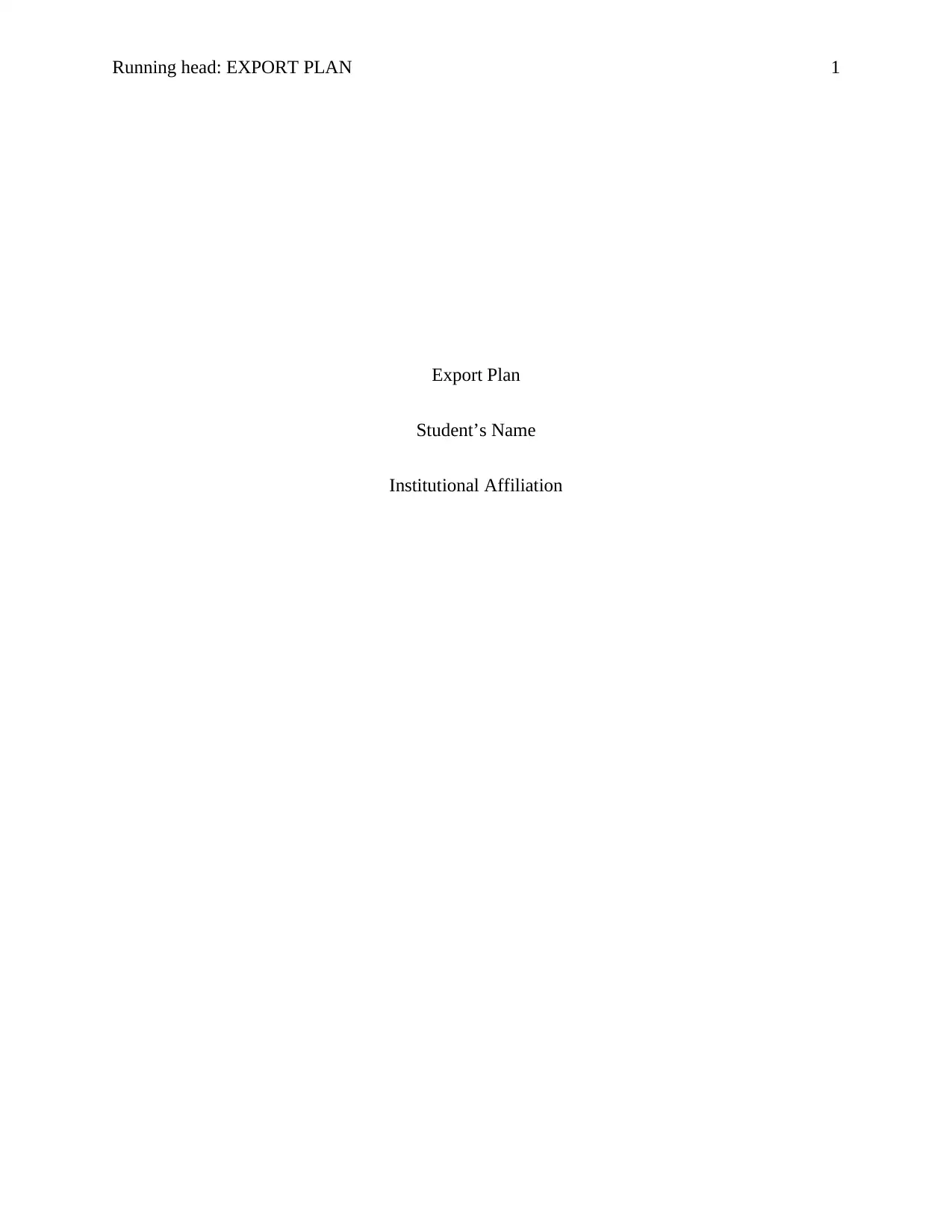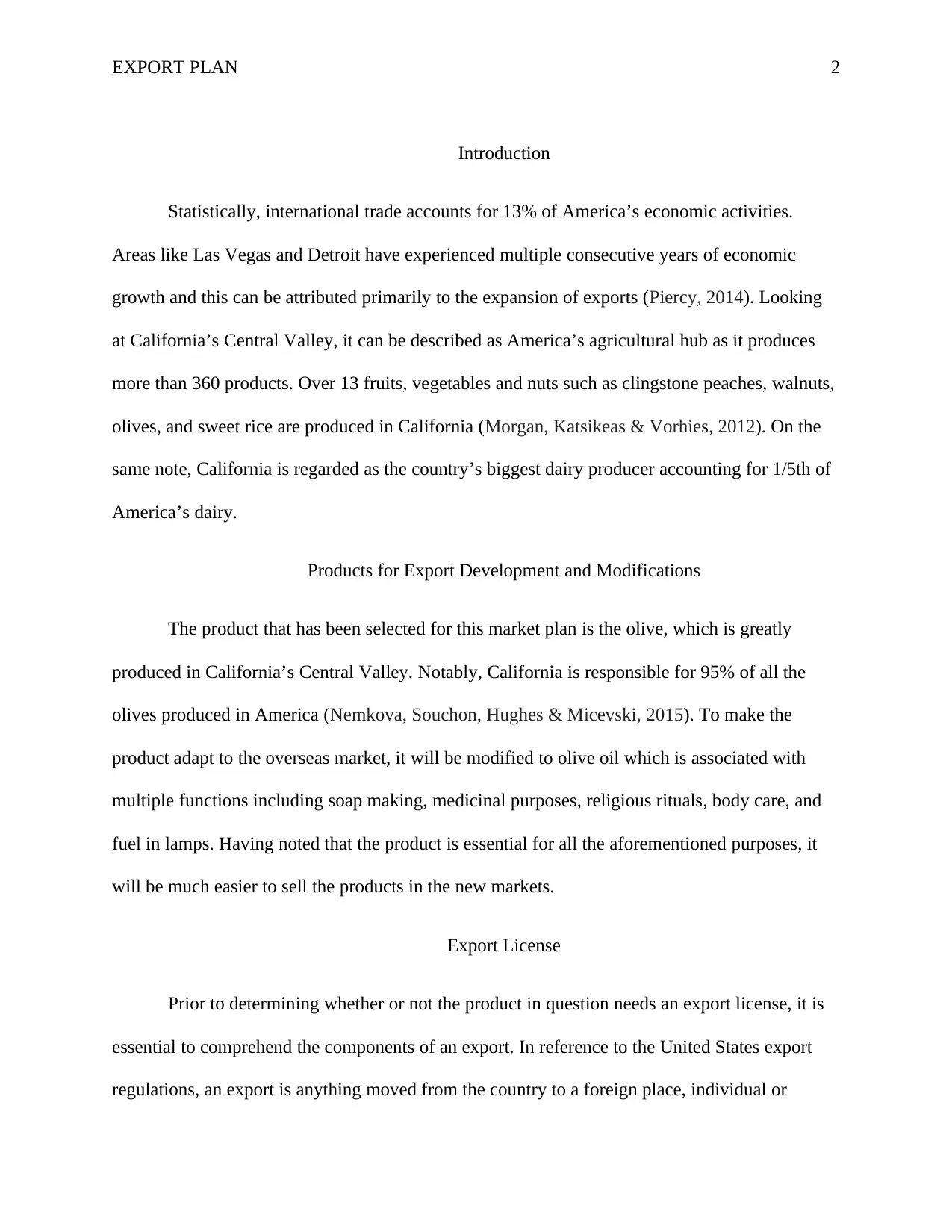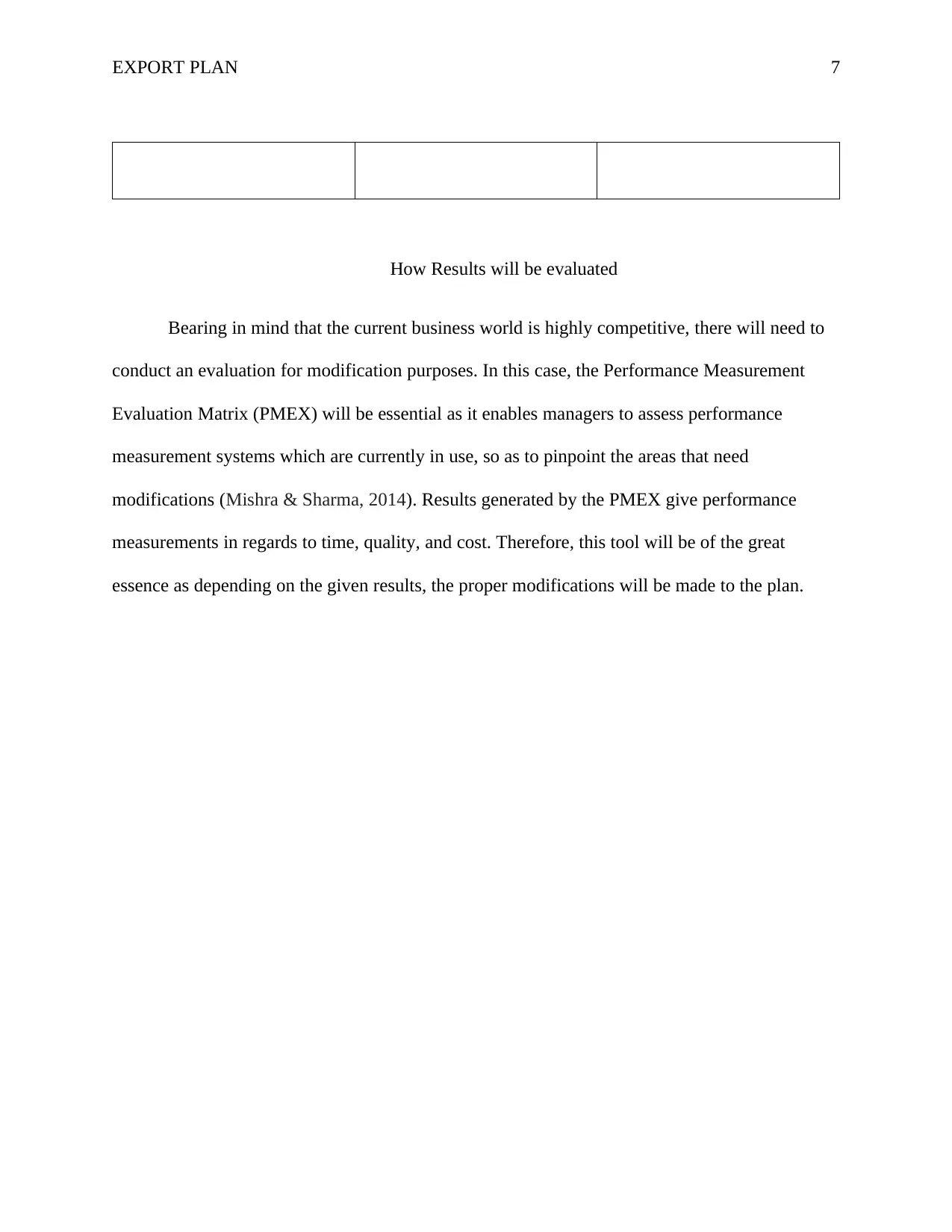Export Plan for Olive Oil in Mediterranean Countries
VerifiedAdded on 2023/06/14
|9
|1932
|166
AI Summary
This export plan outlines the steps to export olive oil to Mediterranean countries, including product modification, target markets, customer profiles, marketing and distribution channels, challenges, pricing, and evaluation of results.
Contribute Materials
Your contribution can guide someone’s learning journey. Share your
documents today.

Running head: EXPORT PLAN 1
Export Plan
Student’s Name
Institutional Affiliation
Export Plan
Student’s Name
Institutional Affiliation
Secure Best Marks with AI Grader
Need help grading? Try our AI Grader for instant feedback on your assignments.

EXPORT PLAN 2
Introduction
Statistically, international trade accounts for 13% of America’s economic activities.
Areas like Las Vegas and Detroit have experienced multiple consecutive years of economic
growth and this can be attributed primarily to the expansion of exports (Piercy, 2014). Looking
at California’s Central Valley, it can be described as America’s agricultural hub as it produces
more than 360 products. Over 13 fruits, vegetables and nuts such as clingstone peaches, walnuts,
olives, and sweet rice are produced in California (Morgan, Katsikeas & Vorhies, 2012). On the
same note, California is regarded as the country’s biggest dairy producer accounting for 1/5th of
America’s dairy.
Products for Export Development and Modifications
The product that has been selected for this market plan is the olive, which is greatly
produced in California’s Central Valley. Notably, California is responsible for 95% of all the
olives produced in America (Nemkova, Souchon, Hughes & Micevski, 2015). To make the
product adapt to the overseas market, it will be modified to olive oil which is associated with
multiple functions including soap making, medicinal purposes, religious rituals, body care, and
fuel in lamps. Having noted that the product is essential for all the aforementioned purposes, it
will be much easier to sell the products in the new markets.
Export License
Prior to determining whether or not the product in question needs an export license, it is
essential to comprehend the components of an export. In reference to the United States export
regulations, an export is anything moved from the country to a foreign place, individual or
Introduction
Statistically, international trade accounts for 13% of America’s economic activities.
Areas like Las Vegas and Detroit have experienced multiple consecutive years of economic
growth and this can be attributed primarily to the expansion of exports (Piercy, 2014). Looking
at California’s Central Valley, it can be described as America’s agricultural hub as it produces
more than 360 products. Over 13 fruits, vegetables and nuts such as clingstone peaches, walnuts,
olives, and sweet rice are produced in California (Morgan, Katsikeas & Vorhies, 2012). On the
same note, California is regarded as the country’s biggest dairy producer accounting for 1/5th of
America’s dairy.
Products for Export Development and Modifications
The product that has been selected for this market plan is the olive, which is greatly
produced in California’s Central Valley. Notably, California is responsible for 95% of all the
olives produced in America (Nemkova, Souchon, Hughes & Micevski, 2015). To make the
product adapt to the overseas market, it will be modified to olive oil which is associated with
multiple functions including soap making, medicinal purposes, religious rituals, body care, and
fuel in lamps. Having noted that the product is essential for all the aforementioned purposes, it
will be much easier to sell the products in the new markets.
Export License
Prior to determining whether or not the product in question needs an export license, it is
essential to comprehend the components of an export. In reference to the United States export
regulations, an export is anything moved from the country to a foreign place, individual or

EXPORT PLAN 3
organization. Bureau of Industry and Security (BIS) is tasked with the role of implementing and
enforcing the Export Administration Regulations (EAR) (Saraswati, 2013). Notably, only those
items that are listed in the Commerce Control List (CCL) require export licenses. In this case.
Olive oil is not on the list, and therefore, the export license is not needed.
Targeted Countries for Sales Development
Olive oil market appears complex as it extends in the developing and developed
countries. The market is recognized through various production systems and it is traded globally.
Therefore, the targeted countries for sales development of olive oil are the Mediterranean
countries. These countries include Algeria, France, Egypt, Greece, Syria, Slovenia, Spain, Libya,
Morocco, Turkey, Tunisia, Malta, Lebanon, Israel, Albania, and Bosnia (Hajkowicz, Cook &
Littleboy, 2012). The consumption of olive oil is developing in the Mediterranean countries,
however, it differs with patterns based on quality and quantity. Market segmentation matters as
product qualities play great roles in consumption decisions within the countries.
Customer Profiles, Marketing, and Distribution Channels
The basic customer profiles in the Mediterranean countries depends on the demographic
size as well as per capita income. For instance, consumption in Spain, Greece, and Italy is
targeted for elder individuals who have ample knowledge concerning olive oil. In addition, in
countries such as France and Italy, olive oil is mostly consumed by persons between 13-14
individuals and especially rich families who can cope with the expenses of purchasing the
products. Moreover, the traditional consumers especially females indicates high consumption
rates as they are aware of qualities and benefits of olive oil such as beauty and medicinal
organization. Bureau of Industry and Security (BIS) is tasked with the role of implementing and
enforcing the Export Administration Regulations (EAR) (Saraswati, 2013). Notably, only those
items that are listed in the Commerce Control List (CCL) require export licenses. In this case.
Olive oil is not on the list, and therefore, the export license is not needed.
Targeted Countries for Sales Development
Olive oil market appears complex as it extends in the developing and developed
countries. The market is recognized through various production systems and it is traded globally.
Therefore, the targeted countries for sales development of olive oil are the Mediterranean
countries. These countries include Algeria, France, Egypt, Greece, Syria, Slovenia, Spain, Libya,
Morocco, Turkey, Tunisia, Malta, Lebanon, Israel, Albania, and Bosnia (Hajkowicz, Cook &
Littleboy, 2012). The consumption of olive oil is developing in the Mediterranean countries,
however, it differs with patterns based on quality and quantity. Market segmentation matters as
product qualities play great roles in consumption decisions within the countries.
Customer Profiles, Marketing, and Distribution Channels
The basic customer profiles in the Mediterranean countries depends on the demographic
size as well as per capita income. For instance, consumption in Spain, Greece, and Italy is
targeted for elder individuals who have ample knowledge concerning olive oil. In addition, in
countries such as France and Italy, olive oil is mostly consumed by persons between 13-14
individuals and especially rich families who can cope with the expenses of purchasing the
products. Moreover, the traditional consumers especially females indicates high consumption
rates as they are aware of qualities and benefits of olive oil such as beauty and medicinal

EXPORT PLAN 4
purposes. Also, in Spain, the marketing and distribution channels used are the supermarkets and
hypermarkets as there are most shoppers in the Mediterranean countries.
Challenges
Marketing of olive oil is associated with various challenges. For instance, competition
from other exporters such as Portugal. Therefore, the Mediterranean countries have to consider
the tastes and preferences of consumers to keep up with the quality and quantity production of
olive oil as expected. The challenge of competition can be addressed if the exporting countries
develop effective pricing strategies. Cultural differences are associated with changes in
consumption among the countries. The challenge can be addressed if consumers of olive oil are
informed about qualities and benefits of olive oil. Finally, imports and exports control such as
tariffs and quotas should also be addressed (Serra, Pointon & Abdou, 2012). Duty-free imports
should be allowed to overcome the issue.
Determination of Export Sales Prices
Four essential factors must be present for the export sales to make good profits. These
elements include an excellent pricing of the olive oil, issuing an accurate and complete quotation,
identifying the sale terms, and choosing a payment method. Of the four aforementioned
elements, pricing can prove to be more problematic as a consequence of the different pricing
structures and market forces evident across the globe. Therefore, when setting the price, the
crucial factors to consider will be competition, market demand, the objectives of the company in
the foreign markets, and costs related to the product. Besides this, the factors of insurance,
financing, transportation, duties, and taxes.
purposes. Also, in Spain, the marketing and distribution channels used are the supermarkets and
hypermarkets as there are most shoppers in the Mediterranean countries.
Challenges
Marketing of olive oil is associated with various challenges. For instance, competition
from other exporters such as Portugal. Therefore, the Mediterranean countries have to consider
the tastes and preferences of consumers to keep up with the quality and quantity production of
olive oil as expected. The challenge of competition can be addressed if the exporting countries
develop effective pricing strategies. Cultural differences are associated with changes in
consumption among the countries. The challenge can be addressed if consumers of olive oil are
informed about qualities and benefits of olive oil. Finally, imports and exports control such as
tariffs and quotas should also be addressed (Serra, Pointon & Abdou, 2012). Duty-free imports
should be allowed to overcome the issue.
Determination of Export Sales Prices
Four essential factors must be present for the export sales to make good profits. These
elements include an excellent pricing of the olive oil, issuing an accurate and complete quotation,
identifying the sale terms, and choosing a payment method. Of the four aforementioned
elements, pricing can prove to be more problematic as a consequence of the different pricing
structures and market forces evident across the globe. Therefore, when setting the price, the
crucial factors to consider will be competition, market demand, the objectives of the company in
the foreign markets, and costs related to the product. Besides this, the factors of insurance,
financing, transportation, duties, and taxes.
Paraphrase This Document
Need a fresh take? Get an instant paraphrase of this document with our AI Paraphraser

EXPORT PLAN 5
Specific Operational Steps
There are several operation steps that must be taken, each having its specific timeframe.
The first step will involve conducting an assessment to determine the company’s readiness for
exports. The U.S. Commercial Service offers a helpful and comprehensive questionnaire to
gauge a company’s readiness for exports. The second step will involve developing an export plan
which shows commitment to exporting, unites everyone in the company, and can be used as a
tool for success and progress evaluation (Fujita & Thisse, 2013). Third, the company will
identify the target market, prepare the market, and sell to the market. The fourth step will entail
going online or what is commonly referred to as E-Commerce. An e-business strategy is
essential as many international businesses are using it and it also increases productivity,
minimizes costs, and boosts sales (Leeflang, Verhoef, Dahlström & Freundt, 2014). The final
steps entail getting paid and establishing a logistical support. A logistical support is needed
because the company has to define a method of transporting products as thus the need for
documentation, labeling, packing, and shipping details for export purposes.
Timeframe
The implementation of the entire plan is proposed to take a maximum of two years. Some
of the key elements notable in this plan include selection and modification of the product,
identifying the target market, identifying the customer profiles and marketing distribution,
setting an accurate price, and evaluation of results. Statistically, all the elements are projected to
take a timeframe of 3 months at maximum except the evaluation of results which will require a
maximum of 12 months to establish accurate and reliable results.
Specific Operational Steps
There are several operation steps that must be taken, each having its specific timeframe.
The first step will involve conducting an assessment to determine the company’s readiness for
exports. The U.S. Commercial Service offers a helpful and comprehensive questionnaire to
gauge a company’s readiness for exports. The second step will involve developing an export plan
which shows commitment to exporting, unites everyone in the company, and can be used as a
tool for success and progress evaluation (Fujita & Thisse, 2013). Third, the company will
identify the target market, prepare the market, and sell to the market. The fourth step will entail
going online or what is commonly referred to as E-Commerce. An e-business strategy is
essential as many international businesses are using it and it also increases productivity,
minimizes costs, and boosts sales (Leeflang, Verhoef, Dahlström & Freundt, 2014). The final
steps entail getting paid and establishing a logistical support. A logistical support is needed
because the company has to define a method of transporting products as thus the need for
documentation, labeling, packing, and shipping details for export purposes.
Timeframe
The implementation of the entire plan is proposed to take a maximum of two years. Some
of the key elements notable in this plan include selection and modification of the product,
identifying the target market, identifying the customer profiles and marketing distribution,
setting an accurate price, and evaluation of results. Statistically, all the elements are projected to
take a timeframe of 3 months at maximum except the evaluation of results which will require a
maximum of 12 months to establish accurate and reliable results.

EXPORT PLAN 6
Personnel and Resources to be used in Exporting
The company’s management, as well as the employees, will be equally dedicated to the
realization of the plan. There will have to be an in-house international expertise, an export
department, and time allocated by the senior management will be put into consideration. Also,
the company will have to set aside a budget for production, transportation, salaries marketing,
and other operations.
Time and Money for each Element
The time and money allocation will be based on the five key elements which include
selection and modification of the product, identifying the target market, identifying the customer
profiles and marketing distribution, setting an accurate price, and evaluation of results
Element Budget Time
Selection and
modification
$300,000 3 months
Identifying the target
market
$4,000 3 months
Identifying customer
profiles and marketing
distribution
$3,000 3 months
Price setting research $500 3 months
Evaluation of results $4,000 12 months
Personnel and Resources to be used in Exporting
The company’s management, as well as the employees, will be equally dedicated to the
realization of the plan. There will have to be an in-house international expertise, an export
department, and time allocated by the senior management will be put into consideration. Also,
the company will have to set aside a budget for production, transportation, salaries marketing,
and other operations.
Time and Money for each Element
The time and money allocation will be based on the five key elements which include
selection and modification of the product, identifying the target market, identifying the customer
profiles and marketing distribution, setting an accurate price, and evaluation of results
Element Budget Time
Selection and
modification
$300,000 3 months
Identifying the target
market
$4,000 3 months
Identifying customer
profiles and marketing
distribution
$3,000 3 months
Price setting research $500 3 months
Evaluation of results $4,000 12 months

EXPORT PLAN 7
How Results will be evaluated
Bearing in mind that the current business world is highly competitive, there will need to
conduct an evaluation for modification purposes. In this case, the Performance Measurement
Evaluation Matrix (PMEX) will be essential as it enables managers to assess performance
measurement systems which are currently in use, so as to pinpoint the areas that need
modifications (Mishra & Sharma, 2014). Results generated by the PMEX give performance
measurements in regards to time, quality, and cost. Therefore, this tool will be of the great
essence as depending on the given results, the proper modifications will be made to the plan.
How Results will be evaluated
Bearing in mind that the current business world is highly competitive, there will need to
conduct an evaluation for modification purposes. In this case, the Performance Measurement
Evaluation Matrix (PMEX) will be essential as it enables managers to assess performance
measurement systems which are currently in use, so as to pinpoint the areas that need
modifications (Mishra & Sharma, 2014). Results generated by the PMEX give performance
measurements in regards to time, quality, and cost. Therefore, this tool will be of the great
essence as depending on the given results, the proper modifications will be made to the plan.
Secure Best Marks with AI Grader
Need help grading? Try our AI Grader for instant feedback on your assignments.

EXPORT PLAN 8
References
Fujita, M., & Thisse, J. F. (2013). Economics of agglomeration: cities, industrial location, and
globalization. Cambridge university press.
Hajkowicz, S. A., Cook, H., & Littleboy, A. (2012). Our Future World: Global megatrends that
will change the way we live. The 2012 Revision. CSIRO, Australia.
Leeflang, P. S., Verhoef, P. C., Dahlström, P., & Freundt, T. (2014). Challenges and solutions
for marketing in a digital era. European management journal, 32(1), 1-12.
Mishra, P., & Sharma, P. (2014). Green marketing: Challenges and opportunities for
business. BVIMR Management Edge, 7(1).
Morgan, N. A., Katsikeas, C. S., & Vorhies, D. W. (2012). Export marketing strategy
implementation, export marketing capabilities, and export venture performance. Journal
of the Academy of Marketing Science, 40(2), 271-289.
Nemkova, E., Souchon, A. L., & Hughes, P. (2012). Export decision-making orientation: an
exploratory study. International Marketing Review, 29(4), 349-378.
Nemkova, E., Souchon, A. L., Hughes, P., & Micevski, M. (2015). Does improvisation help or
hinder planning in determining export success? Decision theory applied to
exporting. Journal of International Marketing, 23(3), 41-65.
Piercy, N. (2014). Export Strategy: Markets and Competition (RLE Marketing). Routledge.
Saraswati, J. (2013). A National Export-Led Growth Plan. Economic & Political Weekly, 48(7),
21.
References
Fujita, M., & Thisse, J. F. (2013). Economics of agglomeration: cities, industrial location, and
globalization. Cambridge university press.
Hajkowicz, S. A., Cook, H., & Littleboy, A. (2012). Our Future World: Global megatrends that
will change the way we live. The 2012 Revision. CSIRO, Australia.
Leeflang, P. S., Verhoef, P. C., Dahlström, P., & Freundt, T. (2014). Challenges and solutions
for marketing in a digital era. European management journal, 32(1), 1-12.
Mishra, P., & Sharma, P. (2014). Green marketing: Challenges and opportunities for
business. BVIMR Management Edge, 7(1).
Morgan, N. A., Katsikeas, C. S., & Vorhies, D. W. (2012). Export marketing strategy
implementation, export marketing capabilities, and export venture performance. Journal
of the Academy of Marketing Science, 40(2), 271-289.
Nemkova, E., Souchon, A. L., & Hughes, P. (2012). Export decision-making orientation: an
exploratory study. International Marketing Review, 29(4), 349-378.
Nemkova, E., Souchon, A. L., Hughes, P., & Micevski, M. (2015). Does improvisation help or
hinder planning in determining export success? Decision theory applied to
exporting. Journal of International Marketing, 23(3), 41-65.
Piercy, N. (2014). Export Strategy: Markets and Competition (RLE Marketing). Routledge.
Saraswati, J. (2013). A National Export-Led Growth Plan. Economic & Political Weekly, 48(7),
21.

EXPORT PLAN 9
Serra, F., Pointon, J., & Abdou, H. (2012). Factors influencing the propensity to export: A study
of UK and Portuguese textile firms. International Business Review, 21(2), 210-224.
Serra, F., Pointon, J., & Abdou, H. (2012). Factors influencing the propensity to export: A study
of UK and Portuguese textile firms. International Business Review, 21(2), 210-224.
1 out of 9
![[object Object]](/_next/static/media/star-bottom.7253800d.svg)

